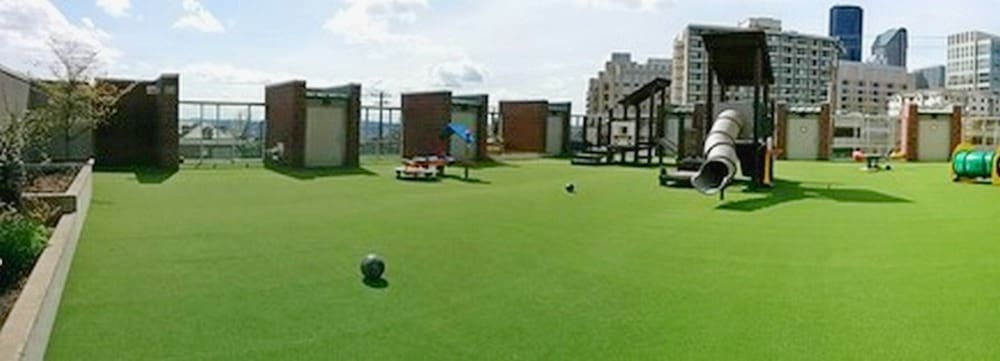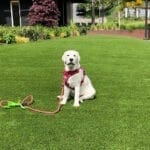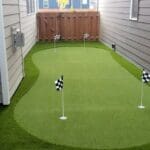With the rise of globalization, the demand for modern sporting facilities is also on the rise. A recent report estimates the global market for artificial turf to reach up to $4.20 billion come 2027. The biggest industry players are multinational companies such as Domo Sports, Act Global, and Shaw Sports.
Fake grass is also a go-to option for many landscapers, thanks to its low maintenance, weather resistance, and zero irrigation needs. With the hope of hybrid artificial grass technology, we can expect new industry growth opportunities in the coming years.
However, who are the pioneers of artificial grass? How did it end up so popular all over the world? This article answers what fake grass is called across the turf industry and explains its rise, popularity, and applications. So, let’s dive into the fundamentals.
What is Fake Grass Called?
What is fake grass called? It’s a question you probably ask every time you visit soccer pitches or large training grounds. Artificial turf comprises a large surface of grass-like synthetic fibers. The popular name for artificial grass is AstroTurf, coined during the late 20th century when artificial turf became popular. Monsanto developed the first artificial turf using ChemGrass and rebranded it to AstroTurf.
But generally, the most used terms for this product are:
- fake grass
- fake turf
- faux grass
- artificial grass
- artificial turf
- artificial lawn
- synthetic grass
- synthetic turf
- synthetic lawn
- or any combination of the above with terms like “grass mat”, “grass carpet” or “grass rug” mostly when used in indoor applications.
Note that these are all terms used interchangeably, but there are many different types of products with different characteristics, pros & cons – these usually have their own brand or model names, numbers, and codes. You can visit our product category page for an example overview of different types of products and naming patterns.
Now on to the story of how it all started…
The History of Artificial Turf/ Fake Grass
The first artificial grass came into existence in 1960, thanks to David Chaney. Chaney had just moved to North Carolina, where he later served as a Dean at the College of Textiles in North Carolina State University.
The First Application of Artificial Turf
Moses Brown school installed the first artificial turf for recreational use in 1964. However, the first prominent application of artificial turf came two years later in Major League Baseball. The teams could now play on the artificial turf at the Houston Astrodome after their attempts failed in 1966. Artificial turf replaced real grass, grown when the stadium opened. But, the Houston Astrodome managed to install the artificial turf in the infield only. The outfield remained with real grass until early summer in 1966. The popularity of artificial turf applications grew across the US and Canada in the 1970s.
First Generation Artificial Turf
The first application of artificial grass had its challenges. First, the industry had limited suppliers for artificial grass. The industry had to find a quick solution for the growing demand. Manufacturers started using polypropylene in the first generation synthetic turf. Unlike nylon fiber, polypropylene is a cheaper, readily available material. After that, even homeowners started ordering artificial turf mats for landscaping applications.
Secondly, the players had difficulties using the field during the second season. Many players complained about more joint injuries sustained on artificial turf than real grass. This raised many safety and quality concerns from across the sports industry.
Team doctors reported that their players experienced more burns and blisters and blamed it on artificial turf. Unlike natural grass, artificial turf didn’t have natural cooling effects during extreme temperatures. Other complaints include difficulties playing games because balls bounced harder on the artificial turf. Also, the first artificial turf had a short lifespan and degraded quickly after prolonged exposure to sunlight. None of these issues are present with modern synthetic turf – if you pick the right one for your use case.
Second Generation Artificial Turf
Again, manufacturers had to respond fast to these concerns with better, high-quality material. As a result, the industry innovated the second-generation artificial turf. These artificial grass carpets had long turfs with wide spaces.
Manufacturers spread sand in these spaces for greater firmness and stability. This innovation resolved the problem of ball bouncing and rolling. Players and fans could now enjoy quality games without the ball shooting off all over the place.
Third Generation Artificial Turf
However, things didn’t yet get rosy for the artificial turf industry. By the early 1990s, football and baseball teams started switching back to natural grass. Still, the playing ball “characteristics” on the second generation artificial turf didn’t match natural grass. Even so, the initial challenges of natural grass such as maintenance, sunlight demands, and deterioration risks still prevailed.
Manufacturers came up with innovative, revolutionary improvements, giving rise to the third generation artificial turf. This new-generation artificial turf hard grass blades with infill materials. This new creation prevented the artificial grass from compacting. Also, the new design included a drainage system for easy maintenance.
Another improvement in the new-generation artificial turfs is the construction material. Manufacturers resorted to polyethylene fibers instead of polypropylene. Unlike polyethylene, polypropylene is much softer and gentle on the skin. This improvement allowed players to perform slide tackles with minimal injuries. Also, the third-generation turfs had sand, and rubber granules mixture spread between the artificial grass blades to offer more stability.
Artificial Turf Applications in Modern Sports
As noted, baseball became the first sport to use artificial turf in the Major League. Tropicana field had the first new-generation turf installed in 2000. However, most teams resorted to natural grass, with only a few using artificial turfs for big games. Let’s look into the history and growth of artificial turf in other sports:
American Football
The Houston Oilers became the first American Football League team to play on artificial turf after moving to Houston Astrodome in 1968. The Philadelphia Eagles became the second American Football team to play on artificial turf after installing artificial grass on their Franklin Field in 1969. However, the popularity of artificial turf applications in American Football grew in the early 2000s. Although CenturyLink Field had planned to use natural grass in 2002, the constructors resorted to artificial turf after Seattle Seahawks reported a positive experience with the artificial grass at Husky Stadium during the 2000/2001 season.
Cricket
Cricket is among the latest sports to switch to artificial turf in the US. The country witnessed the first artificial grass cricket field in 2016 at Fremont, California. However, the type of turf used in cricket is hybrid, primarily a combination of natural and artificial grass. Other synthetic grass fields are available all over the UK.
Canadian Football
The Empire Stadium became the first sporting complex to install artificial infield turf in Canada in 1970. BC Lions used the stadium for regular training and matches at that time. However, Frank Clair Stadium in Ottawa, now renamed TD Place Stadium, became the first sporting complex to install artificial turf in 2002. Other stadiums for Canadian football teams also replaced first and second-generation artificial turfs from 2002 to 2007, when Saskatchewan Roughriders renovated their Taylor Field.
Field Hockey
The application of artificial turf in hockey fields is more straightforward than in other sports. Playing hockey requires speed, allowing the installation of short blade turfs. That means that hockey fields can still maintain earlier versions of artificial turf. The use of artificial turf in field hockey started as early as the 1970s in western countries.
However, many local communities don’t prefer artificial turf for hockey fields. The short synthetic fibers make it nearly impossible to use them for other sports. Similarly, building two stadiums can be challenging due to the financial resources required.
Association Football
Artificial turf gained popularity in Association Football in the 1980s, until the late 1990s when most clubs abandoned it due to high cases of injuries. Many fans criticized artificial grass fields and referred to them as plastic pitches. Loftus Road arena, home to QPR, became the first football field to install artificial turf in 1981, followed by Kenilworth Road in 1985. Others included Athletic Boundary Park in 1986 and Deepdale, also in 1986.
Artificial Turf in 2015 Women World Cup
The 2015 Women World Cup is probably the most prominent sports tournament to happen entirely on artificial turfs. Canada, the host country for the soccer tournament, uses synthetic grass in most stadiums due to the area’s climate. Although nearly 50 athletes protested against the organization’s decision to use artificial turfs, the Australian team noted no big difference between playing on natural and artificial grass.
In locations like Canada where weather conditions can be too harsh for natural grass, fields with artificial turf represent a better option for large events and sports competitions as weather conditions simply don’t influence the quality of the pitch as much as with natural grass.
Rugby
Artificial turf is popular in rugby fields used by English premiership teams, especially at professional levels.
Unlike natural grass, artificial turf offers more durability, ideal for rigorous rugby actions. On top of that, it’s less susceptible to harsh weather elements. Among the English premiership teams using artificial turf on their rugby fields include Worcester Warriors and Saracens FC. The Pro14 teams using artificial turf include Glasgow Warriors and Cardiff Blues.
Golf
Last but not least, we have Golf, probably one of the leading sports behind most of the technology development and advances in artificial grass manufacturing and design. Golf greens products and Golf green installation are among the foundational services that Synthetic Turf has been dealing with since the company’s beginnings.
Golf is very specific because you can see (and feel) different types of greens in a single field or golf course.
Home and Commercial Applications of Artificial Turf
Arid western states adopted the use of artificial turf in landscaping from the 1990s. This is probably because residential and commercial applications didn’t present many challenges as sports. However, installing artificial turf in your landscape in these years can be pretty tricky. Many homeowners had to defend themselves in court or uninstall the turf due to new water savings programs. Some states will require you to plant a minimum number of plants for ecosystem balance.
Before installing artificial turf in your landscape, you would want to check the local by-laws first. Some county legislations oppose hardscaping to preserve water-permeable surfaces and natural gardens.
Artificial Turf in Airport Applications
Airports are the leading commercial customers for artificial turf. Why? Artificial grass provides various advantages for airport operations than natural grass. For instance, it offers high visual contrast with paved runways to minimize accidental landings. On top of that, wildlife doesn’t support wildlife. This reduces foreign objects that can pose risks during landing and takeoff. Besides, artificial turfs have no rocks or clumps.
There are other innovations in airport artificial turf applications. Modern manufacturers integrate fiber-optic fibers for runway lighting, especially if the turf has a drainage system.
These lighting features are also ideal for commercial advertising.
What Are the Benefits of Artificial Turf?
Besides asking yourself what is fake grass called, do you wonder why artificial turf is so prevalent in sporting applications? Do you know why homeowners wish they could replace their natural grass landscape with artificial turf?
For a detailed overview of the benefits of artificial grass, check out this in-depth article. The main takeaways of that would be:
Prolonged Durability
Artificial turf can withstand the test of bad weather and heavy use for ages without showing any signs of wearing out. Unlike natural grass, it doesn’t burn in hot weather. Even better, artificial turf doesn’t degrade in heavy rains or when it’s snowing.
This durability saves the team a lot of time and money spent on re-turfing natural grass fields.
Easy Maintenance
On top of durability, artificial turf attracts hassle-free maintenance throughout all seasons. Unlike natural grass, you don’t need to water, fertilize, or mow artificial turf to keep it in usable conditions. Instead, you only need to brush the surface before or after every game to reshape the blades. Also, you can brush at least once a week to clean the surface.
Great Performance
Apart from wondering what is fake grass called, have you stepped on it? New-generation artificial turf feels like natural grass, and you can hardly tell the difference. Besides the soft touch, the infill sand and rubber mixture gives the turf real grass lawn properties; they are firm and have the same bounce.
Reliable for Daily Playing or Training
Artificial turfs are reliable for daily playing and training, regardless of the day’s weather. Unlike natural grass, synthetics fields are impervious to water and have drainage systems to keep them dry throughout the year. Moreover, players can use artificial turfs for up to 3,000 hours a year, unlike 700 for natural grass.
Improved Safety
Contrary to many opinions, the designing and manufacturing of artificial turfs consider many safety measures for end-users. For instance, modern artificial turfs have foam padding, providing an extra layer to protect players from direct impact with the concrete.
Even better, new-generation artificial turfs comply with all the slip-resistance, traction, stability, and rotation standards set by international sports federations and leagues.
Conclusion & Making The Transition
Generally, artificial turf is a go-to option for many covered stadiums because it doesn’t require sunlight during the day.
For outdoor applications, synthetic grass fields are popular as they facilitate playing and training in all weather conditions.
Sports are becoming more fun and thrilling on artificial turf. Although artificial grass is applicable in any sport, it is most prevalent in football, rugby, baseball, and soccer.
If you are a homeowner or a business owner and want to level up your turf game, there’s never been a better time to do it. Call us and give your turf a permanent low-maintenance makeover.





